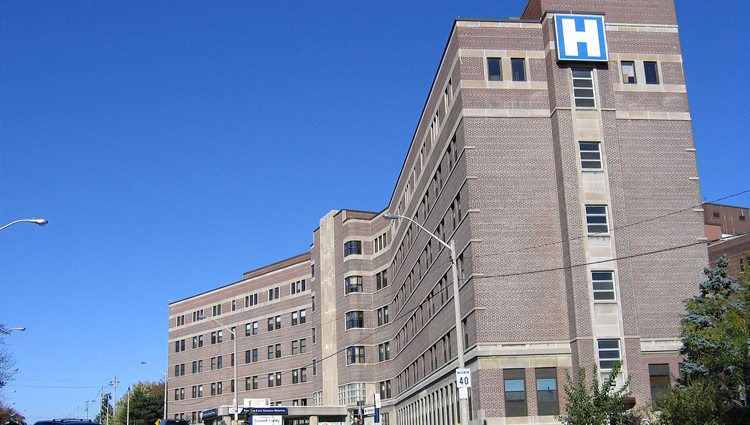Hushing Noisy Hospitals

Michael Garron Hospital, formerly Toronto East General Hospital, is a community teaching hospital in Toronto, Ontario.
(Inside Science) -- It's midnight in New York-Presbyterian hospital, and one patient -- call her Helen -- can't get to sleep. Heavy medication has blocked the pain in her abdomen, but the noise is intolerable and lasts all night.
Voices echo in the hallway. Doctors are paged. Porters bang equipment as they clean. Alarms on heart monitors ring. And the woman in the next bed cries constantly.
"Nothing about my hospital experience was calming or soothing or encouraging healing," Helen complained in a survey about her stay (her real name was withheld for reasons of privacy).
She isn't alone in her frustration. In hospital surveys across the country, noise is one of the most common complaints. Some patients even check out early, before their recovery is complete, to get a good night's rest at home.
Hospital noise is taking a toll on the well-being of patients and contributing to errors by staff, a growing body of research suggests.
"Over the last three decades the noise in hospital has increased to a point where it now clearly has the potential to interfere with speech and sleep," said Ilene Busch-Vishniac, an acoustical scientist and the provost of McMaster University in Hamilton, Canada.
This year, many states will finally do something about the problem. Across the country, new building codes will for the first time require newly-constructed hospitals to meet minimum noise standards before opening their doors.
These new standards, however, do not address noise levels in the 6,000 or so existing hospitals across the United States, which are loud and getting louder.
Loud and Getting Louder
Noise levels are about three or four times higher today than they were in 1960, said Busch-Vishniac, who in 2005 analyzed half a century of recordings collected at dozens of hospitals around the world.
Her data showed that hospitals now average 72 decibels during the day, the volume of an alarm clock, and 60 decibels at night, as loud as a dishwashing machine. And some pieces of equipment -- such as portable X-ray machines -- produce sounds louder than the 90 decibel roar of a passing motorcycle on the highway.
Much of this noise comes from human voices, from the daily conversations and communications that fill a bustling hospital.
Some of the noise is an unfortunate byproduct of safety standards. Alarms on heart monitoring equipment are required to be twice as loud as the background noise. Ventilation and air conditioning systems bellow as they are pushed harder to meet stricter federal standards for air flow. And smooth, shiny surfaces are easy to clean but tend to reflect sounds.
"Hospital noise is a continuous din, a muddle of sounds," said Busch-Vishniac. "It's like a cave with a rock band playing in it."
"I hear complaints about noise from my patients every day," said Ashish Jha, a practicing general internist and a professor at the Harvard School of Public Health.
In a standardized national survey, 54 percent of patients said that their rooms were kept quiet at night. Hospital room noise was the most common patient complaint, beating out other quality of care indicators such as room cleanliness and clear communications from the staff, according to Jha's analysis of this survey, the 2008 Assessment of Healthcare Providers and Systems.
More than just an annoyance, hospital noises can disrupt sleep in ways that a patient may or may not remember, said Jo Solet of Harvard Medical School in Boston. She recorded the daily sounds of the Somerville Hospital in Massachusetts and brought them to a sleep clinic to measure their effect on sleep quality.
Twelve healthy adult volunteers spent two nights in bed surrounded by the soundtrack of ringing telephones, chattering voices, and clanking carts. As a group, they remembered waking up 35 times. Their recorded brain waves confirmed these recollections and revealed numerous other awakenings throughout their sleepless nights.
"These were healthy volunteers, and they couldn't sleep well," said Solet, who published the research in April. "We ask sick people to endure these conditions every day in hospitals."
Lack of sleep also has well-established effects on the mind -- muddling alertness and triggering irritable, aggressive moods -- but little is known about how noise and poor sleep quality actually affect recovery from illness. What researchers have shown is that sharp, sudden sounds can quicken heart rate. Airplane and traffic noise at night can raise the blood pressure of a sleeper, even if he doesn't wake up. And long-term sleep deprivation has been connected to a variety of health problems, from diabetes to stroke.
The research echoes the words of Florence Nightingale who, writing in 1860, described unnecessary noise as "the most cruel absence of care which can be inflicted either on sick or well."
Back to the Drawing Board
Texas A&M University professor Roger Ulrich and the Center for Health Design in Concord, Calif., have called for architects to return to the drawing board and redesign the modern hospital to tackle the noise problem.
"The conventional ways that hospitals are designed contribute to stress and danger," he wrote in a 2005 report that reviewed 600 scientific studies showing that a hospital's physical environment can have an impact on quality of care.
"The community really took notice of this report and started working to address this problem," said David Sykes, an acoustical consultant. He and a committee of scientists who study sound developed the first acoustical guidelines for the healthcare industry, which spent $45 billion on construction in 2009, according to the U.S. Census Bureau.
These guidelines, published in January by the Facility Guidelines Institute, will be used to shape the building code regulations of 46 states over the next year. In some states, such as New Jersey, newly-constructed hospitals will be mandated to meet the guidelines in their entirety before opening for business. Other states, such as California, have decided to make them optional for new hospitals and in-patient facilities.
Facilities built according to the guidelines must keep patient rooms below 45 decibels; hallways, below 50 -- about the equivalent of being inside a normal home. To accomplish this, they will need to incorporate quieter HVAC systems and building materials that meet minimum sound-absorbing ratings.
The goal is not only to make patients more comfortable but also to cut down on medical errors.
Internal studies at Kaiser Permanente that followed nurses through their daily tasks found that in a chaotic, noisy environment the chance of a nurse's making a mistake was fairly high, said John Kouletsis, National Director of Strategy, Planning, and Design for Kaiser Permanente.
In a warehouse near Oakland International Airport in California, Kouletsis is studying what changes will need to be made to meet the new guidelines. In a mock hospital ward that looks like a Hollywood-style set, they test the sound-absorbing capabilities of carpeting, ceiling tiles, and thicker walls.
"We're trying to find out what is the minimum amount of cost that it would take to achieve the sound levels in the new guidelines," said Kouletsis.
Quieter, Hospital Zone
No state will apply the new standards to existing hospitals, where overhauls tend to be expensive and often technically challenging.
The Johns Hopkins Hospital in Baltimore, Md. is one of few voluntarily paying for retrofits, with the help of a team of acoustical engineers. They've started by installing sound-absorbing panels in a hematology ward. Noise is particularly problematic in this ward because it is shaped like a square donut, so sounds tend to reflect off the smooth walls and bounce around and around in a circle.
Traditional materials that could dampen sound -- like those in concerts halls and recording booths -- don't meet the strict standards for flammability, ease of cleaning, and bacterial resistance required in a hospital setting. Their soft fibers provide the perfect breeding ground for bacteria that can contribute to hospital-acquired infections.
Timothy Hsu, a graduate student studying acoustical engineering at the Georgia Institute of Technology in Atlanta, helped Johns Hopkins Hospital test and install new panels made of Tyvek, a bacteria-resistant cloth made by DuPont and used for medical packaging.
"These panels are making a measurable difference to staff members," said Hsu. Nurses surveyed by Hsu reported improvements in their ability to concentrate and communicate in the now-paneled hallways.
Other hospitals are rethinking their floor plans to move noise away from the patients. The Methodist Hospital in Indianapolis relocated a nursing station -- a busy hub of activity -- away from patient rooms to quiet things down. The Karamanos Cancer Institute of Detroit, Mich. credited a 30 percent drop in medical errors to a similar move and to new ceiling tiles.
Small changes in equipment are also making a difference. Nurses at a Bronx hospital switched to soft-soled shoes and plugged earphones into the television sets. Officials at Mayo Clinic in Rochester, Minn. added padding to medical chart holders and replaced rolling paper towel dispensers with a silent alternative: folded paper towels.
Alarms on equipment that monitors patients' vital signs have become an increasing cause for concern. Their purpose is to be shrill and alerting, but a preponderance of false alarms often leads to the machines being silenced, according to James Keller, vice president of health technology evaluation and safety for the Philadelphia-based ECRI Institute, a nonprofit that conducts research and consults for hospitals, health care facilities, and government agencies. This "alarm fatigue" contributed in April to the death of a Massachusetts General Hospital patient whose heart monitor alarm was turned off, according to a federal investigation.
New alarm technologies that send messages directly to nurses are being developed, as well as other new ways of communicating -- such as secret service-style earphones -- that replace loud overhead PA systems and ringing phones.
Quieting the equipment is only part of the solution, said Solet. She worked with the Somerville Hospital to change the behavior of its staff in ways that would stick. As part of a new "quiet time" protocol, they adjusted medication schedules to avoid waking up patients and installed noise monitoring devices to remind nurses to speak softly at night. Patient complaints dropped by 38 percent and the use of sedatives to help patients sleep was cut in half.
"We need more training and staff awareness," said Solet. "It might seem like a regular daytime job to them, but you can't talk in a normal voice when people are sleeping ten feet away."

